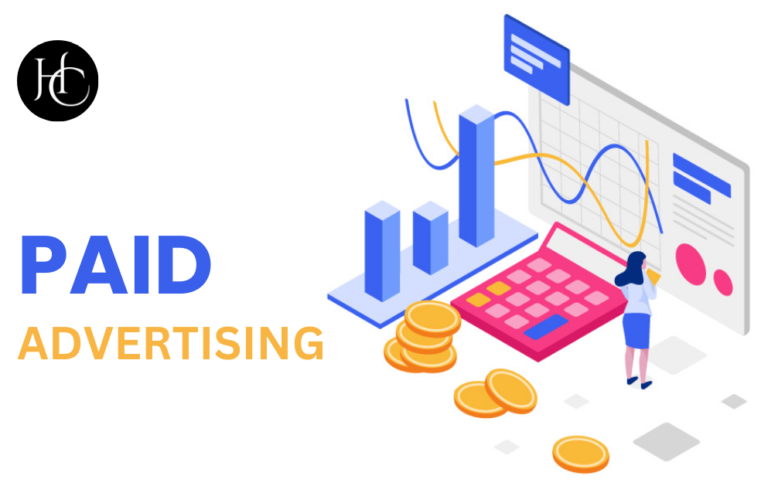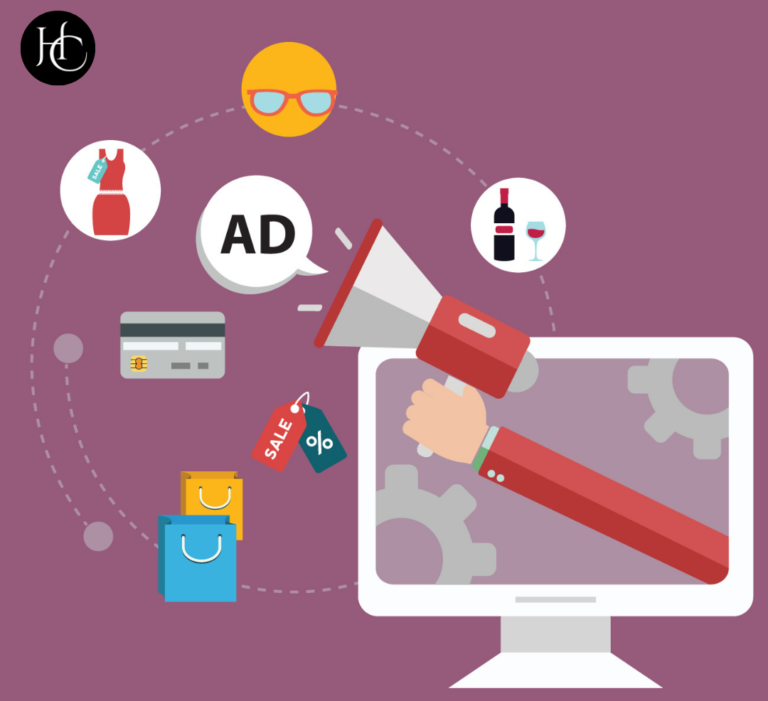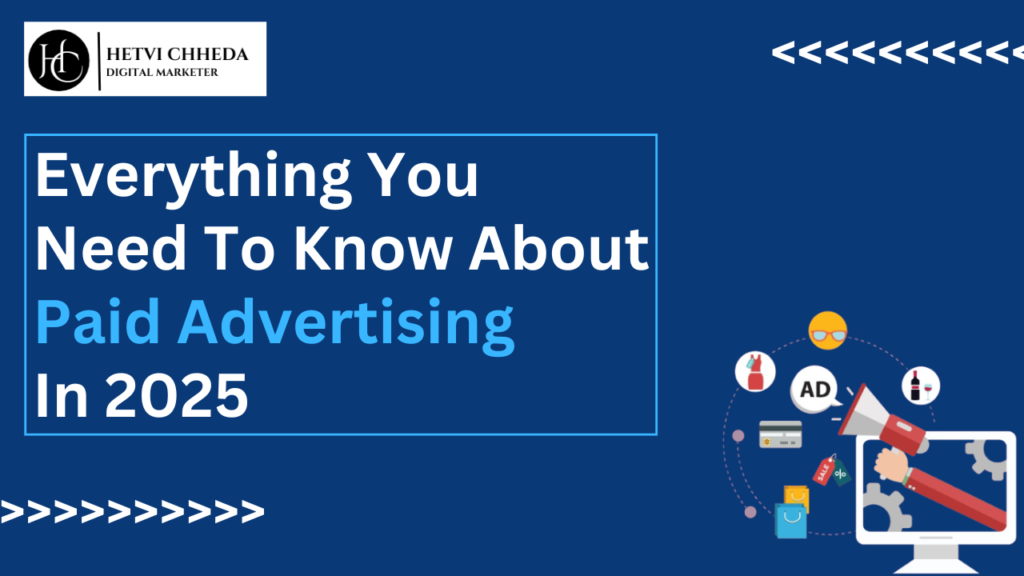What is Paid Advertising?
Paid advertising is a digital marketing strategy where businesses pay to display their promotional content on various platforms to reach a targeted audience. Unlike organic marketing, which relies on SEO and content marketing, paid advertising provides instant visibility and quicker results.
With paid campaigns, businesses can showcase their offerings through PPC advertising, banner ads, and sponsored content. Major platforms like Google, Facebook, Instagram, LinkedIn, and YouTube offer paid advertising solutions tailored to different business needs. These platforms provide highly customizable ad formats that enable advertisers to focus on the right audience based on demographics, interests, and behaviors.
By investing in paid Google ads or Facebook ads, businesses can increase brand awareness, drive website traffic, and generate leads. These ads operate on a bidding system where advertisers pay based on impressions, clicks, or conversions. Depending on the campaign objectives, businesses can choose from different pricing models such as Cost-Per-Click (CPC), Cost-Per-Impression (CPM), and Cost-Per-Acquisition (CPA).
Another key advantage of paid advertising is the ability to track and measure performance using analytics tools. Businesses can analyze real-time data, adjust strategies, and optimize their ad spend for maximum return on investment. Unlike traditional advertising methods, digital paid campaigns allow for precise targeting, ensuring that promotional messages reach the most relevant audience.
Overall, paid advertising is a powerful tool for businesses looking to accelerate growth, outperform competitors, and achieve specific marketing goals in a cost-effective manner.
How Paid Advertising Works?
Paid advertising follows a structured approach to ensure businesses get the maximum return on investment. The process begins with selecting the right platform, setting up an ad account, defining objectives, and launching the paid campaigns. Paid Advertising strategy helps businesses efficiently reach their target audience and achieve specific goals.
A key aspect of PPC advertising is keyword targeting. Advertisers bid on relevant keywords so that their ads appear when users search for related terms. Paid Google ads work on a pay-per-click basis, meaning businesses only pay when users click on their ads. This model ensures businesses are investing in high-quality traffic that has shown interest in their products or services.
For social media ads like Facebook ads, businesses can target users based on demographics, interests, and online behavior. These platforms use sophisticated algorithms to optimize ad placements and ensure maximum engagement, which ultimately drives better results and return on ad spend (ROAS). Social media platforms also allow advertisers to retarget users who have previously interacted with their brand, enhancing the chances of conversion.
Effective paid advertising also involves A/B testing, monitoring ad performance, and adjusting budgets based on real-time data. By continuously optimizing paid campaigns, businesses can improve their reach, conversion rates, and overall ad effectiveness. With the right strategy, paid advertising becomes a powerful tool to grow brand awareness and drive sales.
Benefits of Paid Advertising
Paid advertising offers numerous advantages for businesses aiming to boost visibility, increase sales, and maximize return on investment. One of the most significant benefits of paid advertising is its ability to deliver immediate results. Unlike organic marketing, which takes time to build traction, paid campaigns allow businesses to quickly appear in front of their target audience. With PPC advertising, brands can drive traffic to their websites almost instantly, making it an ideal strategy for product launches, seasonal promotions, or time-sensitive offers. Additionally, paid Google ads and Facebook ads ensure that businesses reach users actively searching for their products or services, increasing the likelihood of conversions.
Another key advantage of paid advertising is its precise audience targeting capabilities. Platforms like Google and Facebook offer advanced targeting options that allow businesses to segment audiences based on demographics, interests, behavior, and even past interactions. This ensures that ads are shown to the most relevant audience, reducing wasted ad spend and improving engagement rates. Furthermore, with retargeting strategies, businesses can reconnect with users who have previously visited their website, keeping their brand top of mind and increasing conversion chances. By continuously optimizing paid campaigns, businesses can track performance, adjust strategies in real-time, and achieve better ROI, making PPC advertising one of the most effective digital marketing strategies available.

Different Types of Paid Advertising
There are several types of paid advertising, each designed to target different audiences and business objectives. The most popular formats include:
PPC Advertising
This is one of the most common forms of paid advertising where advertisers bid on keywords and pay when users click on their ads. Paid Google ads fall under this category, appearing on search engine results pages based on keyword searches.
Social Media Ads
Platforms like Facebook, Instagram, LinkedIn, Twitter, and TikTok offer businesses the ability to run paid campaigns that reach specific audience segments. These ads can be displayed in feeds, stories, or as sponsored posts, making them highly engaging.
Display Ads
Display advertising involves visual-based ads appearing on websites, apps, and video content. These ads come in various formats, including banners, pop-ups, and rich media ads, and are designed to grab users’ attention as they browse online.
Native Advertising
Native ads blend seamlessly into the content of the platform they appear on, making them less intrusive. These ads look like organic content and often appear in the form of sponsored articles, recommendations, or in-feed ads on social media.
Video Ads
Platforms like YouTube, Facebook, and Instagram offer video-based paid advertising, allowing businesses to create engaging video content to promote products and services. Video ads can be skippable or non-skippable and help capture audience attention effectively.
Remarketing Ads
Remarketing (or retargeting) ads target users who have previously visited a website but didn’t complete a desired action, such as making a purchase or signing up for a service. These ads help businesses re-engage potential customers and encourage them to return.
Setting Clear Goals for Your Paid Campaigns
To achieve success with paid advertising, businesses must set clear and measurable objectives. Some common goals include:
Businesses investing in PPC advertising or paid Google ads should first define their primary objectives. If the goal is to increase website traffic, running high-intent search ads can be an effective strategy. For businesses focused on lead generation, incorporating lead capture forms within Facebook ads or LinkedIn ads can provide a steady flow of potential customers.
Sales-driven campaigns require well-optimized ad creatives and compelling offers. E-commerce businesses often rely on shopping ads and remarketing campaigns to drive conversions. Additionally, companies aiming for brand awareness can benefit from running display and video ads across various platforms.
By setting SMART (Specific, Measurable, Achievable, Relevant, Time-bound) goals, businesses can optimize their paid campaigns effectively and track their success with real-time data.

Targeting the Right Audience Effectively
One of the biggest advantages of paid advertising is its ability to reach a highly targeted audience. Effective audience targeting begins with identifying key customer demographics. Businesses can define their ideal audience based on factors like age, gender, location, interests, and purchasing behavior. Platforms like Google and Facebook offer advanced targeting options that help advertisers refine their audience selection for maximum impact.
Behavioral targeting is another crucial element in PPC advertising. Businesses can track user interactions, previous website visits, and purchase history to create retargeting campaigns that re-engage potential customers. Lookalike audience targeting is another powerful tool that allows businesses to find new customers similar to their existing ones, increasing the chances of conversions.
By continuously analyzing audience data and making adjustments, businesses can ensure their paid campaigns remain cost-effective and result-driven. Regular A/B testing and audience segmentation help further refine targeting strategies for better engagement.
Creating Effective Ad Copy and Visuals
The success of paid advertising heavily depends on engaging ad creatives. Here’s how to craft compelling ads:
- Catchy Headlines – Use attention-grabbing headlines that align with user intent.
- Concise Ad Copy – Clearly communicate the benefits of the offer.
- Strong Call-to-Action (CTA) – Encourage users to take the desired action, such as “Buy Now” or “Sign Up.”
- High-Quality Visuals – Use eye-catching images and videos to enhance engagement.
- A/B Testing – Test different versions of ads to determine what works best.
A well-crafted ad increases click-through rates and improves the overall performance of paid campaigns.
Analyzing and Optimizing Your Campaigns for Better Results
To achieve success with paid advertising, businesses must continuously analyze and optimize their campaigns. Tracking key metrics such as impressions, click-through rates, and conversions provides valuable insights into ad performance. By identifying trends and patterns, advertisers can make informed decisions about budget allocation, bid adjustments, and audience targeting. Platforms like Google Ads and Facebook Ads Manager offer robust analytics tools to help businesses measure the effectiveness of their paid campaigns.
Optimization involves refining ad creatives, adjusting keyword strategies, and testing different ad formats. A/B testing helps determine which ad variations perform best, allowing advertisers to tweak headlines, visuals, and call-to-action elements for better engagement. Additionally, monitoring audience response and feedback enables businesses to make data-driven improvements, ensuring their PPC advertising efforts yield maximum returns.
By continuously evaluating and fine-tuning their campaigns, businesses can enhance efficiency and boost ROI. The key to successful paid advertising lies in ongoing testing, adapting to market trends, and leveraging insights to create compelling, high-performing ads. With a well-optimized paid advertising strategy, businesses can maximize their advertising investment and achieve sustainable growth.
Conclusion
Paid advertising is one of the best ways to reach the right audience, increase sales, and grow your business quickly. With new trends and advanced tools, businesses can run smarter and more effective ad campaigns. Learning these skills through a digital marketing course can help you stay ahead and get the best results. Investing in paid ads is a smart move for long-term success in the digital world. It allows businesses of all sizes to compete effectively and drive measurable results. By staying updated with the latest strategies, you can maximize your ROI and scale your business faster.
FAQs
Paid advertising in 2025 involves businesses paying for ads to appear on platforms like Google, Facebook, Instagram, and others. This form of digital marketing helps companies target specific audiences, drive traffic, and increase conversions. With advancements in AI and machine learning, paid ads have become more targeted, personalized, and cost-effective. Advertisers can now optimize campaigns in real-time to get the best return on investment (ROI), using features like audience segmentation and behavioral targeting.
Paid advertising works by allowing businesses to pay for ad placements on various platforms. Advertisers bid on specific keywords, demographics, or interests to ensure their ads are shown to the right audience. For instance, Google Ads operates on a pay-per-click (PPC) model, where businesses only pay when a user clicks on their ad. Social media ads like Facebook or Instagram target users based on their behaviors and preferences. The goal is to drive relevant traffic that leads to conversions.
The best platforms for paid advertising in 2025 depend on your business goals and target audience. Google Ads is ideal for capturing high-intent searches, while Facebook and Instagram are powerful for reaching broader audiences based on interests and behaviors. LinkedIn is excellent for B2B targeting. Platforms like YouTube also offer significant opportunities for video ads. Choose a platform that aligns with your goals and audience.
Paid advertising offers several benefits, including immediate results, enhanced targeting, and scalability. By leveraging platforms like Google Ads or social media, businesses can reach specific audiences based on their demographics, location, and interests. Paid ads allow for flexible budgets and real-time optimization, ensuring that campaigns are continuously refined for maximum ROI. Additionally, paid advertising helps businesses stay visible in competitive markets, build brand awareness, and drive consistent traffic to websites or landing pages.
Setting a budget for paid advertising depends on your goals, the platform you’re using, and the competitive nature of your industry. Most platforms allow you to choose a daily or lifetime budget, which limits how much you spend on ads over a period. Consider the cost-per-click (CPC) or cost-per-impression (CPM) for your chosen keywords and estimate how much you’re willing to pay for each conversion. Start with a small budget, monitor the results, and adjust based on campaign performance.
Optimizing paid advertising campaigns involves continuous monitoring and adjusting based on performance data. You can improve campaigns by testing ad creatives, target audiences, and bidding strategies. Use the analytics tools provided by platforms like Google Ads and Facebook to identify high-performing ads and underperforming ones. Adjust targeting parameters, allocate more budget to top-performing ads, and conduct A/B tests to refine your approach. Optimization should be an ongoing process to ensure that your ads deliver maximum ROI.
The main difference between organic and paid advertising is that organic results are earned through SEO (search engine optimization) efforts, such as content creation and link building, whereas paid advertising requires a financial investment. Organic results take time to build and grow, whereas paid ads provide immediate visibility. Paid ads allow for more precise targeting, as they let businesses choose specific demographics, behaviors, and interests, while organic methods focus on long-term search engine ranking improvements.
Measuring the success of paid ads involves analyzing key performance indicators (KPIs), such as click-through rate (CTR), conversion rate, cost per conversion, and return on ad spend (ROAS). Platforms like Google Ads and Facebook provide in-depth analytics that help businesses track the effectiveness of their campaigns. By measuring these metrics, businesses can assess whether they’re meeting their objectives, identify areas for improvement, and make data-driven decisions to enhance future ad performance.


